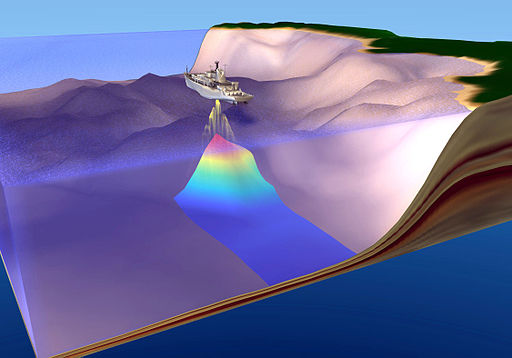How do the continents move?
Harry Hess was a geology professor and a naval officer. He commanded an attack transport ship during WWII. Hess was intrigued by the seafloor maps produced with the ship's echo sounder. He thought about all of the evidence for continental drift. He thought about all of the unusual features of the seafloor. And he found the mechanism to explain them all.
The Evidence Comes Together
World War II allowed scientists to make some puzzling observations. The observations came from seafloor bathymetry and magnetism. These observations are:
- The seafloor has a large mountain range running through it. Deep trenches are found far from the ridges. Guyots have eroded tops that are deep below sea level.
- The magnetic polarity of the seafloor changes. The center of the ridge is of normal polarity. Stripes of normal and reverse polarity are found symmetrical on both sides of the ridge.
- The youngest seafloor is at the ridge. The oldest is farthest from the ridge. The oldest seafloor is much younger than the oldest continent.
Scientists needed to explain these observations.
Mantle Convection
Not long after Wegener's death, scientists recognized that there is convection in the mantle. Deeper material is hotter and so it rises. Near the surface, it becomes cooler and denser so it sinks. This creates a convection cell in the mantle.
Seafloor Spreading
After the war, Harry Hess put together the ideas and evidence he needed. Hess resurrected Wegener's continental drift hypothesis. He reviewed the mantle convection idea. He thought about the bathymetric features and the patterns of magnetic polarity on the seafloor. In 1962, Hess published a new idea that he called seafloor spreading.
Hess wrote that hot magma rises up into the rift valley at the mid-ocean ridges. The lava cools to form new seafloor. Later more lava erupts at the ridge. The new lava pushes the seafloor horizontally away from the ridge axis (figure below). The seafloor moves!
Magnetite crystals in the lava point in the direction of the magnetic north pole. The different stripes of magnetic polarity reveal the different ages of the seafloor.
In some places, the oceanic crust comes up to a continent. The moving crust pushes that continent away from the ridge axis as well. If the moving oceanic crust reaches a deep sea trench, the crust sinks into the mantle. The creation and destruction of oceanic crust is the reason that continents move.
Magma at the mid-ocean ridge creates new seafloor.
- As oceanic crust moves away from the ridge crest, it pushes a continent away from the ridge axis.
- If the oceanic crust reaches a deep sea trench, it sinks into the trench.
- The oldest crust is coldest and lies deepest in the ocean.
The flat topped guyots were once active volcanoes that were above sea level. They were eroded at their tops. As the seafloor moved away from the ridge, the crust sank deeper. The tops of the guyots went below sea level.
The Mechanism for Continental Drift
Seafloor spreading is the mechanism that Wegener was looking for! Convection currents within the mantle drive the continents. The continents are pushed by oceanic crust, like they are on a conveyor belt. Over millions of years the continents move around the planet’s surface. The spreading plate takes along any continent that rides on it.
Summary
- Echo sounders were used to search for enemy submarines during World War II. The depths they recorded allowed scientists to piece together bathymetric maps of the seafloor. Multi-beam sounders work on research vessels today.
- These maps revealed amazing features like mid-ocean ridges, deep-sea trenches, and abyssal plains.
- The features of the seafloor helped scientists to discover the mechanism for continental drift.
- Data from magnetometers dragged behind ships looking for enemy submarines in WWII discovered amazing magnetic patterns on the seafloor.
- The magnetic pole reverses from time to time. The north pole becomes the south pole, and the south pole becomes the north pole.
- Rocks of normal and reversed polarity are found in stripes symmetrically about the mid-ocean ridge axis.
- The seafloor is youngest at the ridge crest and oldest far away from the ridge crest. The oldest seafloor rocks are about 180 million years, much younger than the oldest continental rocks.
- Seafloor spreading is a mixture different ideas and data. Continental drift and mantle convection are supported by bathymetric and magnetic data from the seafloor.
- Harry Hess called his idea “an essay in geopoetry." This could be because so many ideas fit together so well. It could also be because, at the time, he didn’t have all the seafloor data he needed for evidence.
- Seafloor spreading is the mechanism for the drifting continents.





